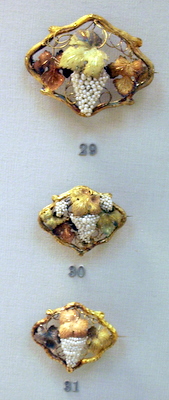|
Historic Seed Pearl JewelryWhat is the process for making seed pearl jewelry? Why was horse hair used for making this jewelry one hundred years ago?
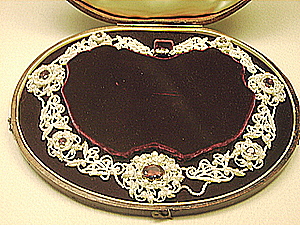 Seed Pearl Necklace - British Museum Note: This information is from a 1908 book. All the seed jewelry mentioned here is from natural pearls and when looking at prices, remember that they are prices from one hundred years ago.
I enjoyed seeing a set of historic seed pearl jewelry at the Pearl Exhibition that is traveling the world. If I remember correctly it belonged to Mrs. Abraham Lincoln. If it wasn't her's, she at least owned one similar. I've also included three colored photos of seed pearl jewelry which I took while visiting the British Museum in London.
Seed pearl jewelry was most in vogue from the year 1840 to 1860. It was generally sold in sets, in a case consisting of a collar, two bracelets, two earrings, a small brooch, and a large spray or corsage ornament. If the object was almost round, occasionally there was a larger central pearl, weighing from one to five grains, usually a button pearl; or, if the ornament was elongated, there were generally three larger pearls. These sometimes possessed a fairly good luster. 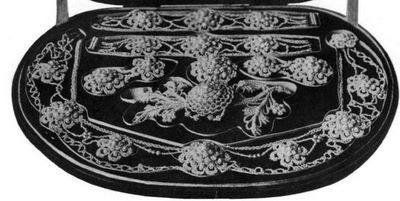 Complete Set of Pearl Jewelry Seed pearl jewelry was at one time so popular, and the values were so small in the United States of America, that a $1,000 seed-pearl set formed a principal feature of the Tiffany exhibit at the International Exposition held at the Crystal Palace, New York, in 1855. Seed-pearl tiaras sold for $75 to $200 or $300 each in 1908. The work was almost entirely done by girls, either German or of German origin. As labor is higher and pearls have advanced in price, none of the old work could now be duplicated for the amount it cost in 1860's or 1870's. The stringing of the pearls on the English scroll means probably twelve hours of continuous work. And efficient pearl worker received $3.50 per day in 1908, which consisted of not more than eight hours, as owing to the very trying character of the work, clear daylight was necessary to see the holes in the small pearls and in the mother-of-pearl shell. 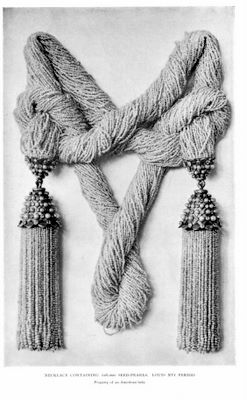 Seed Pearl Ropes
The foundation of all seed pearl jewelry is mother of pearl. The shell is brought in thin plates, measuring from 1 1/2 to 2 1/2 inches square. One of the most popular and attractive patterns is the English scroll. If a design is to be repeated, a brass figure is made. For the fabrication of a brooch, for instance, a design is first made by drawing on a paper or cardboard; then a brass plate or pattern is cut out, leaving spaces wherever there are to be no pearls. After this a slab of stock mother of pearl is then pierced wherever a pearl is to be secured, and the pearls for its embellishment are chosen, and are strung onto the mother of pearl outlines with a special horsehair thread. All the work that remains for the jeweler is the addition of a pin or catch on the back. 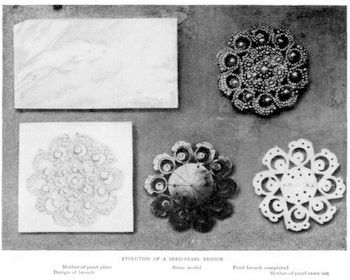 Development of Seed Pearl Brooch Fine horsehair was used for stringing seed pearl jewelry, because the holes drilled in them are usually too small to admit of the use of silk, and it was very important that what is known as pulled hair, taken from a living horse, should be used, as otherwise the hair is too brittle. This hair, in bunches of from eight to fourteen inches in length, was sold at an average price of $1.50 a pound, and frequently only one ounce was selected for use from the entire pound. 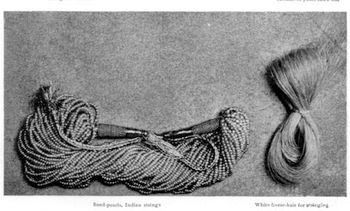 Indian Seed Pearls and Horse Hair
All the pearls used by the seed pearl jewelry workers are purchased in strings and bunches; the finest are those known as the Chinese seed pearls; they were drilled and strung in bunches, weighing three ounces, and were worth, in 1908, $40 per ounce. They were drilled with so fine an aperture that silk will not pass through the pearl, and only horsehair can be used. The Indian madras pearls, however, have a larger drill hole and could be strung wit silk; they were worth, in 1908, from eight to fifteen cents a grain, that was $48 to $90 per ounce. 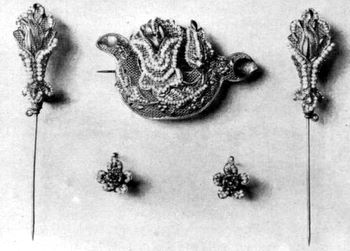 Chinese Seed Pearl Jewelry Nineteenth Century Immense quantities of these very minute pearls were also used in bunches or strings, sometimes as many as twenty or thirty strings being grouped together and either bound straight or else twisted into veritable ropes of pearls. 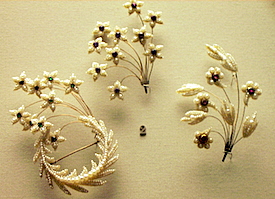 Seed Pearl Pins British Museum Seed pearls were sold by the ounce, a single ounce frequently containing as many as 9,000--that is fifteen pearls to the pearl grain ro sixty to the carat--selling for from $48 to $60 an ounce, in 1908. Naturally, some of these pearls are even smaller than this, but the average is maintained by those that are a little larger.
The price of these small pearls, however, was only, in 1908, from eight to fifteen cents per carat, whereas diamonds of this size were worth, in 1908, from $200 to $300, their value being three times that of those weighing one sixteenth to one eighth carat each. This is due to the fact that the labor expended in cutting the smaller diamonds is much greater than that bestowed upon the pearls, which simply require drilling and not cutting.
Special thanks to Kunz and Stevenson for their 1908 account of making seed pearl jewelry.
See more seed pearl jewelry here.
|



